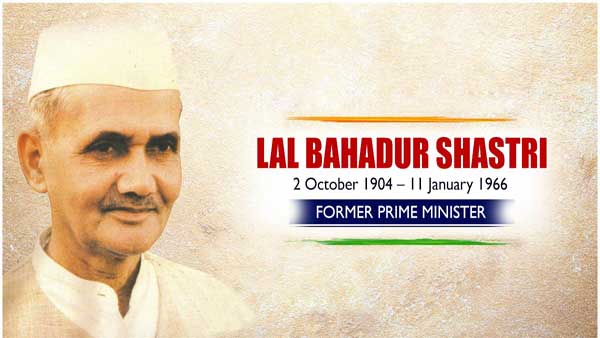
LAL BAHADUR SHASTRI
WHY IN NEWS?
- 2nd October is the birth anniversary of Lal Bahadur Shastri. He served as the second Prime Minister of India.
KEY POINTS
- He was born on 2nd October 1904 in Mughalsarai, a small railway town seven miles from Varanasi in Uttar Pradesh.
- Participated in the freedom movement since 1930.
- He joined the Kashi VidyaPeeth in Varanasi, one of the many national institutions set up in defiance of the British rule.
- ‘Shastri’ was the bachelor’s degree awarded to him by the Vidya Peeth but has stuck in the minds of the people as part of his name.
- He was minister in the Union Cabinet from 1951 to 1956 when he resigned taking responsibility for the railway accident and later from 1957-1964.
- He was India’s second Prime Minister (1964-66).
- During Shastri’s brief Prime Minister ship, the country faced two major challenges. While India was still recovering from the economic implications of the war with China (1962), failed monsoons, drought and serious food crisis presented a grave challenge. The country also faced a war with Pakistan in 1965.
- Shastri’s famous slogan ‘Jai Jawan Jai Kisan’, symbolised the country’s resolve to face both these challenges.
- Shastri’s Prime Ministership ended abruptly on 10th January 1966, when he suddenly expired in Tashkent, then in USSR and currently the capital of Uzbekistan. He was there to discuss and sign an agreement (Tashkent Agreement) with Muhammad Ayub Khan, the then President of Pakistan, to end the war.
- He signed an agreement with then Ceylon (now Sri Lanka) on persons of Indian origin there, in 1964 — an endorsement of the importance of neighbourhood.
- He was the first person to be posthumously awarded the Bharat Ratna (1966).
LIFE LESSONS FROM HIS LIFE:
- Protested against the caste system: Since he didn’t believe in the caste system, he gave up his surname as a young schoolboy. The title “Shastri” was bestowed on him upon graduating from Kashi Vidyapeeth, as a mark of scholarly achievement.
- Patriotic from a young age: As a patriotic young boy, he was inspired by Mahatma Gandhi and his call to join the Non-Cooperation Movement at the young age of 16. In his maiden Independence Day speech in 1964, Shastri told the youth to strive for moral strength and character, “I appeal to our young men to inculcate discipline in themselves discipline and work for the unity and advancement of the nation.”
- Simple living, high thinking: When he married in 1928, at the insistence of his in-laws to accept dowry, he took a charkha (spinning wheel) and some khadi cloth. Even when he passed away, he reportedly had no property in his name and left behind a few books and a dhoti-kurta.
- A compassionate, forward-thinking leader: He had many pioneering initiatives to his credit, such as using water jets to disperse crowds instead of a lathi-charge and making it possible for women to be appointed as conductors in public transport facilities. He also raised the slogan of “Jai Jawan, Jai Kisan” during the Indo-Pakistan war in 1965 and paved the way for India’s food self-sufficiency.
- Honesty was always the best policy: Since the children were rarely allowed to use the official car to go to school when their father was Prime Minister, the family decided to buy a Fiat car for Rs. 12,000. A bank loan for Rs. 5,000 was taken, which Shastri’s widow had to clear after his sudden death, from his pension. On a visit to a textile mill as Prime Minister, when the owner offered to gift him expensive sarees, Shastri insisted on buying and paying for only those he could afford. He also had an undue promotion for his son overturned.
